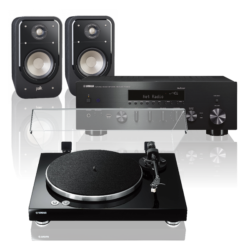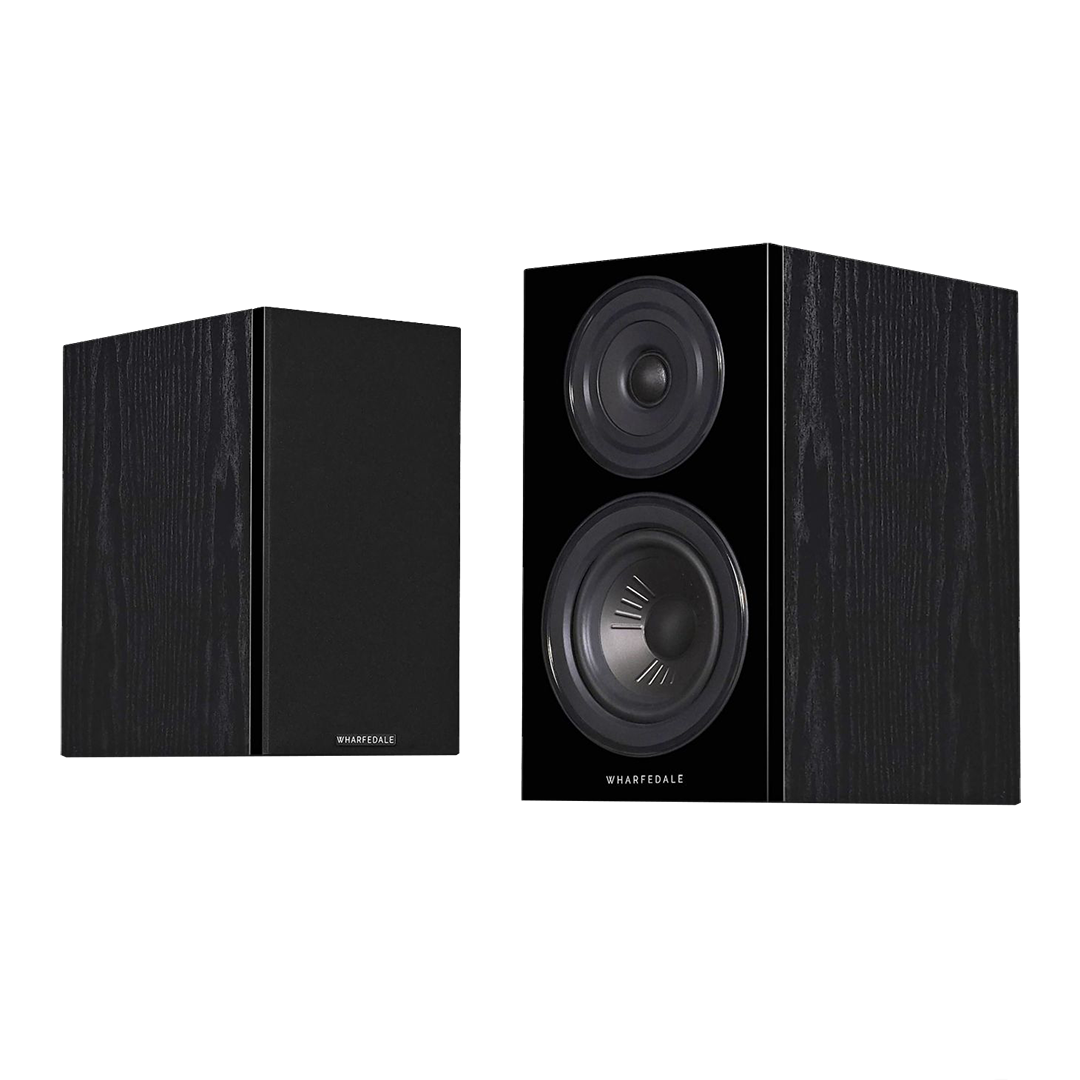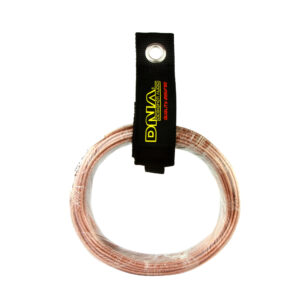
Wharfedale Diamond 12.1 Bookshelf Speakers
The Wharfedale Diamond 12.1 bookshelf speaker could well prove to be the goldilocks in the range. Not too big, not too small, just...
See descriptionThe Wharfedale Diamond 12.1 bookshelf speaker could well prove to be the goldilocks in the range. Not too big, not too small, just right.
With the dramatic clean-sheet redesign of the Diamond 12 range, spearheaded by world-renowned speaker designer Karl-Heinz Fink, Wharfedale have once again raised the bar for what affordable audiophile quality speakers can achieve. At the price, and even well above it, these Wharfedale Diamond 12.1 stand mount speakers are going to be very, very hard to beat.
AUD Inc. GST
The Wharfedale Diamond 12.1 is probably destined to be the best seller in the range because of the stunning performance it offers for the price. Small enough to not dominate a room yet with fire power enough to fill medium size spaces, this is a prime candidate for top consideration. The Diamond 12.1 employs a sweet sounding 25mm (1″) textile dome tweeter and an advanced 130mm (5″) mid/ bass driver constructed of a new material called Klarity which combines traditional polypropylene with mica for added strength and a level of clarity and energy which is truly refreshing.
Developed in Cambridgeshire, England since 1982, Wharfedale’s famous Diamond speakers have served as the classic entry point to true high-fidelity sound, their exceptional sonic value for money earning numerous ‘product of the year’ accolades in the UK and around the world. With the introduction of the Diamond 12 Series, Wharfedale once again raises the bar for affordable, high-performance loudspeakers. However, read on because the following text will give some great insight into the background and design.
New Klarity Driver – The Difference Is Clear
Since the Diamond 8 Series in 2001, Wharfedale has made the mid/bass cones for every Diamond generation from Kevlar. 19 years and many award-wining ranges later, Wharfedale has developed a new composite called Klarity. The chief ingredient of Klarity is polypropylene, a material that has been used to make speaker cones since the BBC researched its use for this purpose in the 1970s. Polypropylene cones are renowned for their characteristically low distortion and controlled ‘breakup’, as well as their resistance to moisture in the air. They also have a reputation in some quarters for sounding a little ‘unexciting’ – a perception that is largely the result of mediocre engineering. When designed and implemented optimally, polypropylene cones can sound enthralling.
To make Klarity, Wharfedale adds mica to the formulation. This increases stiffness compared to polypropylene alone, reducing flexing and enabling a lightweight cone with high rigidity, low colouration and lightning-fast response – ideal characteristics to deliver both accuracy and excitement.
Mid/Bass Drivers – Attention To Detail
Polypropylene speaker cones are often combined with high-damping surrounds to achieve a smooth response curve. However, the hysteresis of these surrounds can restrict dynamics and make bass sound somewhat ‘soft’. For the Diamond 12 Series, the aim was to combine the Klarity cone with a low-damping surround, thereby achieving both low colouration and expressive dynamics. This was not a simple task but, by simulating many different cone shapes and adding ribs to provide further stiffening, a flat response curve was achieved without resorting to a high-damping surround, thereby striking the ideal balance.
The Klarity diaphragms are driven by a substantial, precision-made magnet system with an aluminium compensation ring to minimise the effect of variations in inductance as the voice coil travels. This contributes to an absence of distortion and intermodulation generated by the motor system. The voice coil is wound on a high-power epoxy/glass fibre bobbin – highly unusual in speakers at this price level. This has the advantage of not adding eddy currents and delivering greater power handling than an aluminium bobbin, whilst also being much stiffer than the Kapton type.
Refined Tweeter & Crossover
The Diamond 12 Series’ treble unit sports a 25mm dome made from a woven polyester film with a high-loss coating to deliver open and smoothly extended high frequencies. The magnet system and the front plate have been optimised for wide dispersion and uncompressed behaviour. The front plate is flat and exposes the dome as much as possible, with a short duct to balance the acoustic load and improve the SPL (sound pressure level) measurement.
The treble unit combines seamlessly with the mid/bass driver via a crossover network using an acoustic LKR 24dB topology. This includes air core inductors of the type more commonly found in high-end speakers, selected because they produce the lowest distortion of all inductor types. As the resistance of the coil is higher than a standard laminated steel or ferrite core inductor, the magnetic structure of the mid/bass driver has been modified to compensate, resulting in fast, clean bass with no distortion from the inductor.
Carefully Crafted Cabinet Construction
The cabinet is a critical part of any high-performance loudspeaker. At entry-level price points, corners are often cut to constrain cost, but this is a mistake; no matter how good the drive units, their performance will be wasted if the cabinet’s construction is suboptimal. For this reason, Diamond 12 Series speakers feature cabinets constructed with a level of sophistication usually reserved for much more expensive designs.
Rear Port: The rear-ported enclosure of each model is precisely sized so that the internal volume works in harmony with the drive unit system to deliver the desired sonic result. The cabinet walls are made from sections of wood fibreboard of varying thickness, constructed in such a way as to subdue the identifiable characteristics of the cabinet’s ‘sound’ and ensure the drivers’ output remains unsullied. The resonant properties of each element – even the glue – were considered to determine the ideal combination of materials and placement. Inside the cabinet, Intelligent Spot Bracing connects opposing walls with a specific form of wood brace to achieve optimal reduction of cabinet resonance. These braces are precisely modelled by computer simulation to improve upon the commonplace ‘figure of eight’ brace, which can have the effect of transferring resonance from one wall to another.
About Wharfedale
Wharfedale Wireless Works was founded by Gilbert Briggs in 1932, soon after he built his very first loudspeaker in the cellar of his home in Ilkley, Yorkshire. This sleepy little market town was located in the valley of the river “Wharfe” – an area known to this day as ‘Wharfedale’. This unlikely location would see the birth of a brand that has become recognised all over the world, synonymous with quality in high-fidelity reproduction.
In 1981 the first Wharfedale Diamond speaker was born. The rather unassuming small box took the industry by storm. Small cabinets and the stiff, yet light polypropylene driver meant a very fast, tight sound and compact, accurate two-way drivers produced a fantastic stereo image. It quickly became a best seller and the Diamond range has continued to this day as a staple in the Wharfedale catalogue.
Now, with more than 75 years of setting the standards in perfecting loudspeaker performance, Wharfedale, in order to remain at the forefront of audio, has dedicated 1.5 million square feet to design & manufacturing in which every single product and process takes place in-house. With this ability to control every single part of the process, Wharfedale’s speakers achieve a harmony in performance and design rarely seen elsewhere.
Wharfedale Diamond 12.1 Review
“Wharfedale started with a clean sheet here, and it shows. Pretty much everything is new, from the drive units to the cabinet construction. The result is a pair of compact, 31cm-tall boxes that have the ability to make the most of price-compatible hi-fi components.
Their sound is organised, cohesive and musical. They deliver an impressively expansive soundstage for the money that stays stable even when recordings become layered and demanding. We like the reassuring way the Diamonds handle larger-scale dynamics too, delivering more authority and scale than one might expect for speakers of a modest size and price.
This is a tough area of the market, however, and Wharfedale’s superb speakers aren’t short of talented rivals. Still, the impressive Diamond 12.1 deserve a place on anyone’s shortlist.” What Hi-Fi? – Best British Speakers 2023
Main Features & Specifications
Design: 2-way 2-driver bookshelf speaker
Speaker Stands: Optional Speaker Stands recommended
Enclosure Type: Bass reflex
Transducer Complement: 2-way
Bass Driver: 1 x 130mm (5″) advanced Polypropylene Cone
High-Frequency Driver: 1 x 25mm (1″) Textile dome tweeter
Sensitivity (2.83V @ 1m): 88dB
Recommended Amplifier Power: 20-100 Watts – must be ‘clean’ power
Peak SPL: 96dB
Nominal Impedance: 8 Ohms Compatible
Minimum Impedance: 4 Ohms
Frequency Response (+/-3dB): 65Hz ~ 20kHz
Bass Extension(-6dB): 60Hz
Crossover Frequency: 2.6kHz
Cabinet Volume (in litres): 8.2L
Speaker Wire Terminals: Will accept bare wire or banana plugs
Bi-Wire Capability: Yes
Available Finishes: Black, White, Walnut and Light Oak
Dimensions (WxHxD): 180mm x 312 x 250 mm
Weight: 6.8kg each
Manufacturer’s Warranty: 5 Years. This protects the original purchaser against manufacturing defects but not abuse
Share your thoughts!
Let us know what you think...
Only logged in customers who have purchased this product may leave a review. Log in now
We also recommend
-
16AWG (OFC) Oxygen Free Speaker Cable – 12m
$36.00
Add to cart






















What others are saying
There are no contributions yet.